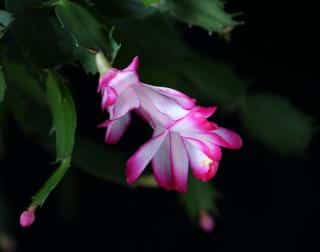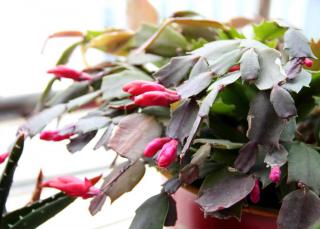

This is the ideal plant to provide warm colors during the cold season. An abundantly flowering succulent, the Christmas cactus will bloom for six to eight weeks every winter.
It’s also an easy plant to care for and grow.
Read also:
Christened Schlumbergera in honor of Frederic Schlumberger, a prominent cactus collector of the XIXth century, Christmas cactus is an epiphyte succulent plant that comes to us straight from the tropical forests of Brazil. It boasts long stems that are assembled from evergreen pseudo-leaves that bear pink, violet, red, orange or white flowers in winter. Since they can grow to reach 24 inches (60 cm) long, these flowing stems make the plant ideal for suspended pot arrangements.
 The Christmas cactus is an easy and hardy plant once the proper place for it has been found. It needs a luminous spot, but with neither direct sun nor drafts of wind. The temperature must constantly hover between 60 and 70°F (15 to 20°C), because it doesn’t like heat. Once you’ve found the spot that it seems to like best, keep it there: it doesn’t like being moved around! Water once a week during the blooming season, and remove wilted flowers one at a time to boost appearance of new flower buds. When the plant isn’t bearing flowers, wait until the soil is dry before watering anew. Repot sometime between February and April more or less every third year, in a blend of soil mix, sand and garden soil.
The Christmas cactus is an easy and hardy plant once the proper place for it has been found. It needs a luminous spot, but with neither direct sun nor drafts of wind. The temperature must constantly hover between 60 and 70°F (15 to 20°C), because it doesn’t like heat. Once you’ve found the spot that it seems to like best, keep it there: it doesn’t like being moved around! Water once a week during the blooming season, and remove wilted flowers one at a time to boost appearance of new flower buds. When the plant isn’t bearing flowers, wait until the soil is dry before watering anew. Repot sometime between February and April more or less every third year, in a blend of soil mix, sand and garden soil.

In fall, place it at rest, without watering, in a room that only gets natural light, for two months, until flower buds appear.
Once the flowering has been triggered, you can bring it back to its original spot.
The Christmas cactus is very easy to propagate through cuttings. Outside of the blooming season, collect a sample stem that counts at least three segments, let it dry in the open air for a couple hours for the cut wound to heal, and then plant it in a pot with equal parts soil mix, garden soil and sand.
Laure Hamann